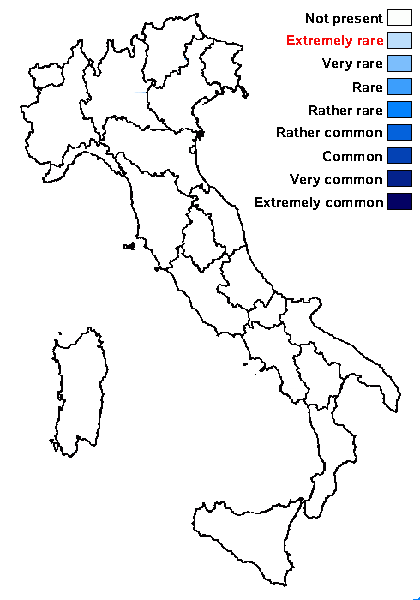Polyblastia tatrana Servít
Českoslov. Lišejn. Čeledi Verrucariaceae: 208, 1954.
Synonyms:
Distribution:
Description: Thallus crustose, episubstratic, verrucose-areolate to subsquamulose-areolate, whitish to pale grey. Perithecia black, c. 0.3 mm across (in section), 1/2-3/4 immersed in the thallus, often clustered. Involucrellum well-developed, surrounding the whole perithecium; exciple brown, pseudoparenchymatous, merged with the involucrellum. Hamathecium of periphyses and periphysoids, interascal filaments absent; hymenial gel I+ red, K/I+ blue Asci 8-spored, clavate, K/I-, fissitunicate, the wall thickened above, with a broad ocular chamber, dehiscent by extrusion of an endotunica to form a delicate rostrum. Ascospores muriform, with 5-7 transverse septa and 1-3 longitudinal septa, at first hyaline then turning pale brown, 20-26 x 10-12 μm. Photobiont chlorococcoid. Spot tests: K-, C-, KC-, P-, UV-. Chemistry: without lichen substances.Note: on soil and plant debris over calcareous rocks in the European mountains, near or above treeline; distribution insufficiently known, because the species was often not distinguished from P. sendtneri, with a few records from the Eastern Alps (Austria), the Tatra Mountains, and the mountains of Albania, but probably still overlooked elsewhere; to be looked for in the Italian Alps.
Growth form: Crustose
Substrata: soil, terricolous mosses, and plant debris
Photobiont: green algae other than Trentepohlia
Reproductive strategy: mainly sexual

Predictive model
Growth form: Crustose
Substrata: soil, terricolous mosses, and plant debris
Photobiont: green algae other than Trentepohlia
Reproductive strategy: mainly sexual

Predictive model
 INDEX FUNGORUM
INDEX FUNGORUM
 GBIF
GBIF

